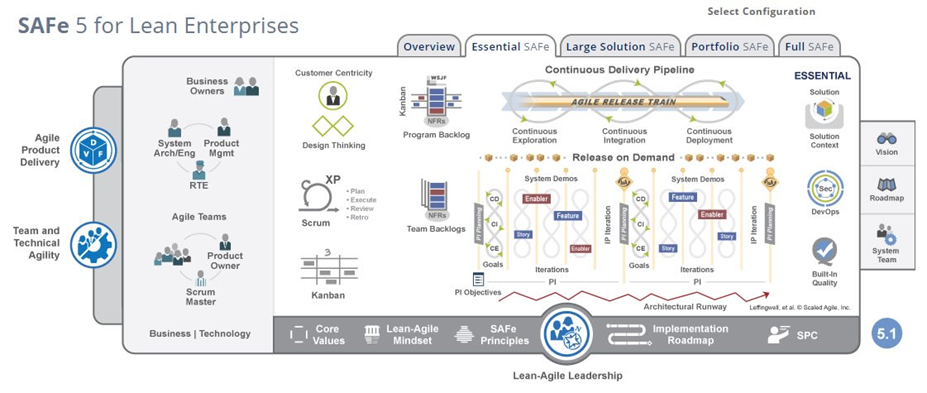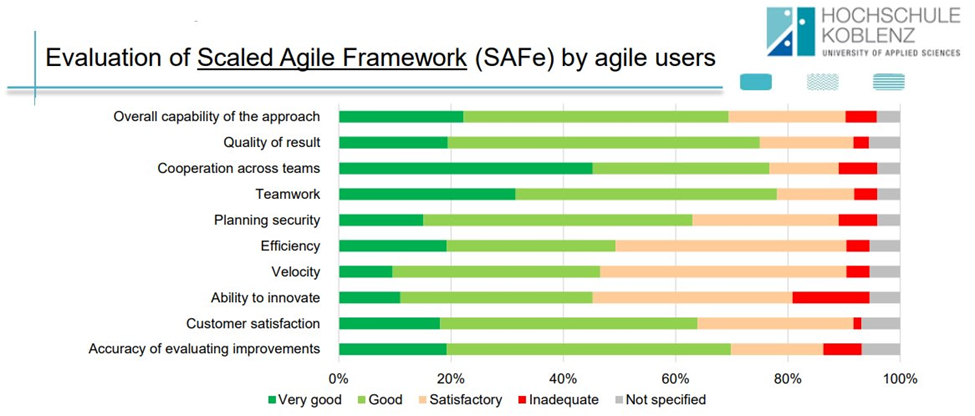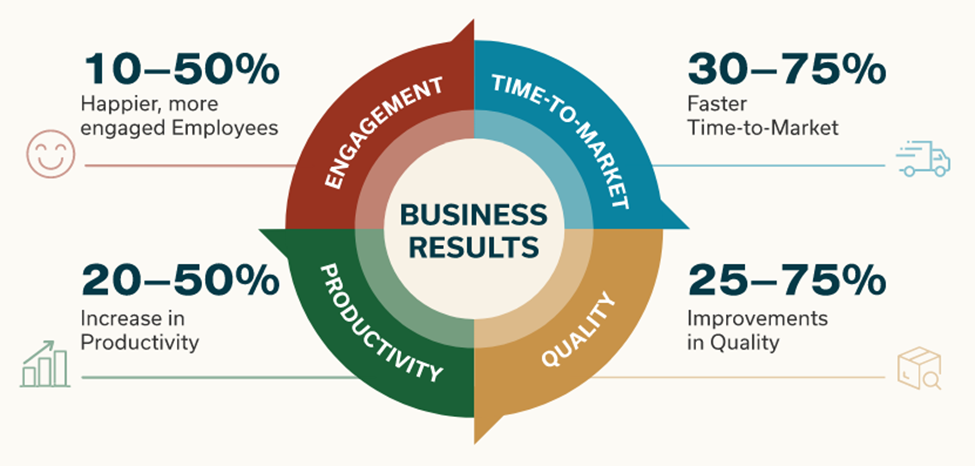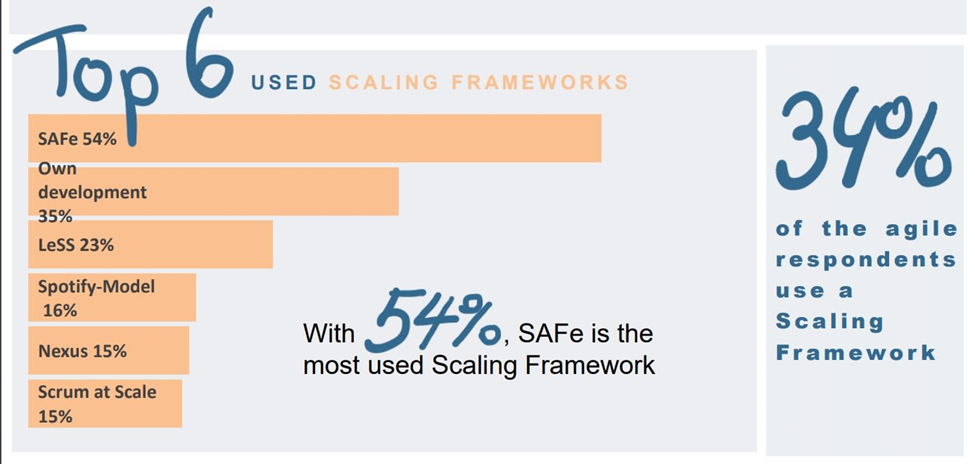04.26.2024
Your Complete Guide To Scaled Agile Framework Certification

Posted by Marbenz Antonio on March 13, 2023
Scaled Agile Framework Certification has become increasingly popular over the past few years as companies strive to achieve more agility in their software development processes. However, for those unfamiliar with the concept, it can be challenging to understand what SAFe is and how it works. This article aims to provide an overview of the Scaled Agile Framework, explaining its core principles and benefits, and providing insight into how it can be implemented in your organization. Whether you are a software developer, manager, or business owner, this article will give you the knowledge you need to understand SAFe and how it can help your organization achieve greater business agility and success.
According to Atlassian, the Scaled Agile Framework Certification is “a set of organizational and workflow patterns for implementing agile practices at an enterprise scale.” The framework provides guidance on roles and responsibilities, planning and work management, and values to uphold.

SAFe aims to foster cooperation, consistency, and efficient project delivery across numerous, agile product delivery teams. It is founded on three key disciplines, including agile software development, lean product development, and systems thinking.
As organizations expand, SAFe presents a well-defined method for implementing lean agile transformation practices at an enterprise scale. The framework comprises four different configurations that cater to different degrees of scaling, which are Essential SAFe, Large Solution SAFe, Portfolio SAFe, and Full SAFe.As businesses expand, SAFe offers a structured approach to scaling agile. There are four SAFe configurations to suit various levels of scale:
(n.d.). What is SAFe? Atlassian. https://www.atlassian.com/agile/agile-at-scale/what-is-safe

The SAFe framework offers several significant advantages, including improved teamwork, enhanced planning predictability, and increased customer satisfaction. Fortunately, these benefits are not just based on claims but are supported by a 2020 study conducted by Koblenz University of Applied Sciences.
Scaled Agile, the organization behind SAFe, reports that over 1,000,000 individuals across 20,000 companies worldwide have recognized the advantages of scaling agile using SAFe. Customer case studies collated by the organization demonstrate typical outcomes such as those mentioned above.

Enhanced time-to-market is a key advantage of scaling an agile team using SAFe. By harmonizing value-centric cross-functional agile teams, major corporations can swiftly address customer requirements. By harnessing the capabilities of the Scaled Agile Framework, they can expedite decision-making, improve communication, optimize processes, and prioritize customer-centricity, all of which help expedite product delivery to the market.
One of SAFe’s fundamental values is built-in quality, which emphasizes the significance of incorporating quality throughout every stage of the development process. Consequently, when organizations scale agile practices using SAFe, quality ceases to be an afterthought and becomes a shared responsibility across all members of the development team.
SAFe facilitates quantifiable enhancements in productivity by empowering high-performing teams and teams of teams to eliminate superfluous tasks, recognize and eliminate bottlenecks, perpetually improve their processes, and ensure that they are constructing the appropriate deliverables.
Improved employee engagement is a valuable outcome of adopting more effective work methodologies, leading to greater staff satisfaction. Scaling agile using the Scaled Agile Framework offers one such benefit by empowering knowledge workers to attain autonomy, mastery, and purpose – the primary drivers of intrinsic motivation. Organizations implementing SAFe have the means to minimize employee burnout and elevate job satisfaction levels.
(n.d.). How the Scaled Agile Framework® Benefits Organizations. Scaled Agile. https://scaledagile.com/what-is-safe/scaled-agile-benefits/

SAFe is by far the most used framework for implementing Agile at scale.
According to data from the 2020 Status Quo (Scaled) Agile report, SAFe is easily the most popular choice.
Over half of Agile enterprises that use scaling frameworks use SAFe. The only close runner-up is custom in-house frameworks.
Upon examining other frameworks, it becomes clear why most organizations opt for SAFe or custom in-house agile frameworks anyway. For instance, the LeSS (Large Scale Scrum) framework prioritizes scaling Scrum without much emphasis on the business processes in a large company, expecting all teams to self-organize. Similarly, the Spotify Model is more of an aspirational model than a framework, as acknowledged by the co-author of the original white paper, and has not been successfully implemented.
(n.d.). SAFe vs. Other Agile scaling frameworks. Monday.com. https://monday.com/blog/project-management/scaled-agile-framework/.
During this two-day course, you will gain the knowledge of seven core competencies necessary to lead a Lean-Agile enterprise by leveraging the Scaled Agile Framework® (SAFe®), and its underlying principles derived from Lean, systems thinking, Agile development, product development flow, and DevOps. This course explores the five competencies needed to become a Lean Enterprise, whilst allowing participants to practice the skills required for supporting and executing Program Increment (PI) Planning events and coordinating multiple Agile Release Trains (ARTs).
(n.d.). Leading SAFe Overview. PM-Partners. https://www.pm-partners.com.au/course/leading-safe-certification/.
The objective of the Scaled Agile Framework’s principles is to enhance the entire organization by encouraging lean-agile decision making that transcends functional and organizational boundaries. These principles are designed to impact not only the leaders and managers but also every individual in the organization, conditioning their mindset to move away from traditional waterfall thinking towards lean-agile thinking. This includes the implementation of practices like Lean Portfolio Management.
This course is designed for individuals in various roles and positions, including:

SAFe aims to transform large enterprises into Lean and Agile organizations by integrating various practices such as Lean, Agile, DevOps, UX, Design Thinking, and more into a comprehensive framework. SAFe brings together these practices to create a recipe that helps large enterprises achieve Agile transformation. It brings forth many valuable concepts, however, the framework can become overwhelming due to the sheer number of ideas presented.
Often, people can get so caught up in understanding and implementing SAFe that they lose sight of the underlying Lean and Agile principles. It’s essential to focus on the “why” before making any modifications to the framework. Instead of solely adhering to SAFe’s recipe, companies need to customize it to fit their specific needs. Unfortunately, many companies fail to reach this level of customization and end up missing the forest for the trees. They prioritize following the SAFe framework over-delivering value to the customer in a timely manner.
(n.d.). What are the objectives and learning goals? Theknowledgeacademy. https://www.theknowledgeacademy.com/au/courses/agile-training/certified-scaled-agile-framework-leading-safe-training-and-exam/
To take this course, it is required that learners hold an undergraduate degree or a high school diploma. Additionally, it is suggested that they have at least five years of experience in software development, testing, business analysis, or project management. It is also recommended that learners have a fundamental comprehension of Agile Scrum.

ANZ bank is “shaking up its management style” by rolling out a ‘Scaled Agile’ approach across its Australian division.
The method of organising and delivering work – used by digital companies like Spotify and Google as well as financial institutions such as ING and ABN AMRO – will improve the way ANZ responds to customer needs and improve productivity, the bank said.
(n.d.). ANZ bank goes all-in with ‘Scaled Agile’ approach. CIO. https://www.cio.com/article/213835/anz-bank-goes-all-in-with-scaled-agile-approach.html

In 2016, consumer technology company, Fitbit, released four new products to the market that were positively received by consumers, and shipped over 22 million devices. Delivering its highest number of products in a year is due in part to the company’s commitment to, and success in adopting other agile frameworks and SAFe® (Scaled Agile Framework®) as a way to scale the team to meet target dates.
FitBit adopted a heavyweight scaled Agile framework between 2015 and 2016 to expand their Scrum efforts. In 2015, they began with 12 Scrum teams and, by 2016, these teams had collaborated on the launch of four new products. On average, there were four teams assigned to each product.
(n.d.). CASE STUDY: Fitbit Fitbit’s Agile Development Journey. Scaled Agile Framework. https://www.scaledagileframework.com/fitbit-case-study/

As cars steadily become “computers on wheels”, Agile management is spreading from software development to the whole firm. Last year, I wrote about Toyota here. Earlier this month, I interviewed Anna Sandberg, who is Head of Continuous Improvement & Change at Product Creation, Volvo Cars in Gotherburg, Sweden. Volvo Cars has around 40,000 employees and produces around 700,000 cars per year.
Volvo Cars had an Agile movement that originated from individuals and software teams who had been adopting Agile practices for a long time. However, the company struggled to expand these efforts. To address this, they aimed to scale the Agile transformation across the software community and the entire product range, including hardware and software. The goal was to develop these components in an integrated manner and keep up with the fast-paced changes in the automotive industry. The company realized that their previous approach was too slow, and they needed to accelerate development.
(n.d.). Why And How Volvo Embraces Agile At Scale. Forbes. https://www.forbes.com/sites/stevedenning/2020/01/26/how-volvo-embraces-agile-at-scale/?sh=579d29e44cf0
SAFe is a suitable option for many companies, and for some, it is an obvious choice. Companies that fall under the following categories can benefit from SAFe:
However, even if your company does not fit perfectly into any of the above categories, it is not a reason to dismiss SAFe entirely. The list is non-exhaustive and emphasizes ideal use cases.

Many applicants inquire, “Is the SAFe Agilist Certification worth it?” Despite numerous inquiries, the value of SAFe Agilist Certification has not diminished in any way.
Obtaining the SAFe Agilist Certification is beneficial as it enables individuals to manage their credentials effectively. This certification also grants access to a wealth of resources, including professional development opportunities, to ensure that their knowledge of SAFe remains current and relevant.
The Leading SAFe 5.1 exam is 90 minutes, and 45 questions with a 35/45 (77%) score required to pass. Questions are multiple-choice, and the exam is taken online after the first course completion (you have a time limit of 30 days to sit the exam). The exam is taken online in your web browser via Scaled Agile’s Community Platform, which you will receive an invite to after registering for a course.
It is not an easy course but most people should pass it if they prepare properly. Scaled Agile categorizes this certification exam as “Foundational; Competent, some knowledge or experience; can perform tasks with assistance”. If you don’t pass on your first attempt you can purchase additional resits for $50 per attempt.
(n.d.). How difficult is the Leading SAFe exam? Medium. https://medium.com/lean-agile-mindset/how-to-prepare-for-and-pass-leading-safe-6468be0534ea
Here are some suggestions to help you pass the Leading Scaled Agile Framework Certification exam:
In conclusion, Scaled Agile Framework (SAFe) has become increasingly popular in recent years, as companies strive to achieve greater agility in their software development processes. SAFe is a set of organizational and workflow patterns for implementing agile practices at an enterprise scale. It offers several significant advantages, including improved teamwork, enhanced planning predictability, increased customer satisfaction, enhanced time-to-market, quality improvement, productivity increases, and improved employee engagement. SAFe is by far the most used framework for implementing Agile at scale, and it is supported by over 1,000,000 individuals across 20,000 companies worldwide.
Here at CourseMonster, we know how hard it may be to find the right time and funds for training. We provide effective training programs that enable you to select the training option that best meets the demands of your company.
For more information, please get in touch with one of our course advisers today or contact us at training@coursemonster.com
